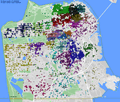|
 |
Computation, Dynamics and the
Phase-Transition
An introduction to finite automata, the Halting Problem and cellular automata is given. An exploration into the dynamics of cellular automata is made and a connection between the theories of computation and dynamical systems is made using the thermodynamic notion of a phase-transition. |
 |
Hydractinia simulation
An agent-based simulation of the Hydractinia colonies and their allorecognition behavior was constructed. We show evidence that the model successfully mimics the phenomenon of colony growth, fusing, rejection (both active and passive), morphological and genotypic mutation, competitive exclusion and the unexpected phenomenon of "buffering". |
 |
Introduction to Cellular Automata and
One-Dimensional Traffic Simulation
Introduction to the theory and properties of cellular automata and how cellular automata can be used a a model for traffic flow. An example one-dimensional model is given. |

|
The Neighborhood Project
An "experiment in collective knowledge", a map of neighborhoods based on the opinion of the people renting, selling and living in them is drawn. The difference in opinion leads to overlap and fuzzy boundaries and provides a sense of where people think they live. |